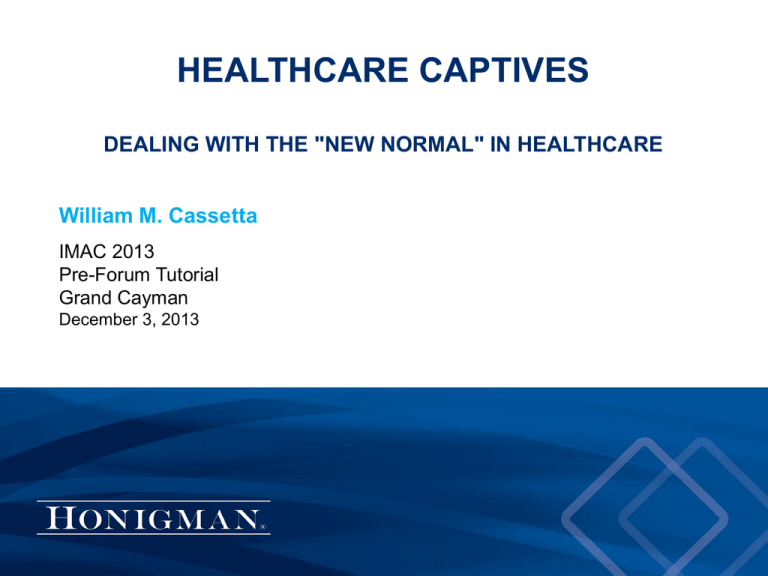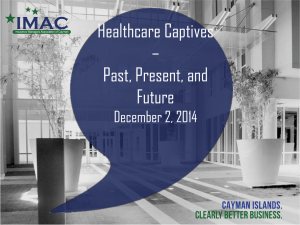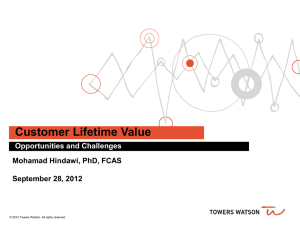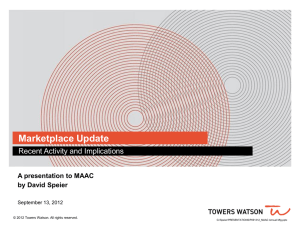
HEALTHCARE CAPTIVES
DEALING WITH THE "NEW NORMAL" IN HEALTHCARE
William M. Cassetta
IMAC 2013
Pre-Forum Tutorial
Grand Cayman
December 3, 2013
HEALTHCARE CAPTIVES – THE NEW NORMAL
Historically, the institutional
healthcare system has been
designed to heal and cure
patients, with a focus on services
in the acute care setting.
2
HEALTHCARE CAPTIVES – THE NEW NORMAL
In the “new normal”, institutional
health care will focus on
“population health management”.
3
HEALTHCARE CAPTIVES – THE NEW NORMAL
Healthcare captives were formed
primarily to help manage medical
professional liability risk.
4
HEALTHCARE CAPTIVES – THE NEW NORMAL
In the “new normal”, captives will
be challenged to help manage
financial risk that extends far
beyond medical professional
liability.
5
HEALTHCARE CAPTIVES – THE NEW NORMAL
Don’t risk a lot to save a little.
Retain risk that is controllable and predictable.
Transfer risk that is volatile or unpredictable.
Retain “owned” risk and transfer “non-owned” risk
Will these continue to be the precepts
of alternative risk financing in the “new
normal”?
6
HEALTHCARE CAPTIVES – THE NEW NORMAL
Employing physicians in large numbers
• Perfect Storm – health systems want to provide full
range of services; physicians fear payment changes if
they remain in private practice
• Is it really “employment”?
Integration into corporate culture of parent?
Willingness to adapt to working for someone else?
Compensation models often resemble private practice
‒ So, newly “employed” physicians have demands that cannot
be ignored
7
HEALTHCARE CAPTIVES – THE NEW NORMAL
Tail Coverage
• Commercial market prices tail coverage unrealistically
• Cost of tail coverage is often a critical factor in the
employment negotiation
• Physicians might have potential personal benefits if
they remain insured by their commercial carriers
What about providing tail coverage
through our captive?
8
HEALTHCARE CAPTIVES – THE NEW NORMAL
Distinguish ability to provide tail coverage from
advisability of providing tail coverage
•
Limited opportunity for coordinated defense
•
Was physician’s prior practice in an unfamiliar/adverse
venue?
•
Does the medical specialty have an especially long tail?
•
Was the physician insured under a policy with a “claims
asserted” trigger?
•
Does the sponsoring organization wish to assume risk for
practice outside the sponsor’s facilities?
•
What if the physician quits/is terminated?
•
Premium tax/potential income tax issues
9
HEALTHCARE CAPTIVES – THE NEW NORMAL
Potential New Best Friend – Physician Insurance Companies?
•
New willingness by physician carriers to entertain collaborative
arrangements with health systems
Concerns about shrinking non-employed physician market
Recognition that “preferred provider” status with predominant health system
may produce greater market share
Apparent willingness to consider nearly any proposed program structure
‒
100% risk transfer
‒
Quota shares
‒
Assumption of prior acts liability only
‒
Access to underwriting services
Reluctance due to historical animosity between hospitals and physicians’
carriers
10
HEALTHCARE CAPTIVES – THE NEW NORMAL
New Exposures/Threats
•
Class action claims
‒
Will current opportunity to limit retained risk be available in the future as excess carriers reconsider “batch”
coverage provisions?
•
Negligent credentialing claims
•
New “agency” theories in clinically integrated networks and ACOs
•
Claims alleging failure to provide care based on economic incentives
•
Antitrust claims for excluding/terminating providers from CIN/ACO
•
Privacy breaches
‒
Who “owns” the electronic medical record that can be accessed by multiple unrelated providers?
•
eMedicine
•
Quality Improvement fatigue
•
Increasing role of non-physician providers
•
Aggressive tax enforcement
•
The insurance market cycle
11
HEALTHCARE CAPTIVES – THE NEW NORMAL
IT WON’T BE EASY, BUT IT
WILL BE INTERESTING!
12
WWW.HONIGMAN.COM
Healthcare Captives –
Dealing with the “New Normal” in
Healthcare
Tom Hermes
Director - Towers Watson
IMAC 2013
Pre-Forum Tutorial
Grand Cayman
December 3, 2013
14
Uncertainty Effects Healthcare Captive Programs
Worldwide economic instability continues
Insurance cycle turning??
Real and manufacturing crises continue
Could affect availability and affordability
Affordable Care Act (AKA Obama Care)
Major restructuring of healthcare industry
– Potential changes to historical risks are not represented in current data
– Changes generate new potential causes of loss requiring coverage – no data
15
© 2013 Towers Watson. All rights reserved. Proprietary and Confidential. For Towers Watson and Towers Watson client use only.
towerswatson.com
The Medical Professional Liability Cycle
Is the Medical Professional Liability (MPL) insurance cycle turning
Property, workers compensation, and commercial auto markets firming
Last MPL cycle turned positive in 2002 (12 years ago) – change is due
Tort reform erosion continues
Major healthcare restructuring creating potential new liability issues
Never events (absolute liability?)
Systematic risk (E.D. System flaws)
Government scrutiny/reporting requirements (Section III) (stents)
Increased public awareness of outcomes (higher expectations)
Some evidence that large claim severity is increasing (while frequency flat)
Increased frequency of class action/batch cases (cardiac stents)
16
towerswatson.com Proprietary and Confidential. For Towers Watson and Towers Watson client use only.
© 2013 Towers Watson. All rights reserved.
Hard Market Cycle Generally Requires a “Perfect Storm”
Substantial increases in frequency and/or severity of claims
Early cycles were frequency driven
Most recent cycle was large loss severity driven
Significant decline in investment return affects leverage
Excess market capacity limited (market demands high attachments/prices)
Cash flow underwriting allows loss ratios excess of 100%
Historically insureds buy down (per claim/agg. limits) during soft market
ultimately resulting in significant working layer losses for excess market
Adverse loss development on prior years loss reserves
Often driven by late reserve development on large cases
HOWEVER
17
towerswatson.com Proprietary and Confidential. For Towers Watson and Towers Watson client use only.
© 2013 Towers Watson. All rights reserved.
Hard Market Cycle Generally Requires a “Perfect Storm”
(continued)
While there is some evidence of increased severity of large claims,
overall trend indications remain moderate (≤ 5%)
Investment returns remain low but relatively stable
Commercial underwriting is more stable – significant excess capacity
As systems have formed, insureds have taken larger retentions with no
aggregates – excess markets are not in the working layer
Low investment income requires better underwriting
Actuarial data improved substantially
Claims reporting, settlement and payment patterns accelerated
Increased healthcare risk management/safety focus has lowered trends
Loss reserve development on prior years is still favorable (graphs)
18
towerswatson.com Proprietary and Confidential. For Towers Watson and Towers Watson client use only.
© 2013 Towers Watson. All rights reserved.
Medical Malpractice Ultimate Loss Est. by Coverage
Year/Valuation Date
19
© 2013 Towers Watson. All rights reserved. Proprietary and Confidential. For Towers Watson and Towers Watson client use only.
towerswatson.com
Medical Malpractice Ultimate Loss Est. by Coverage
Year/Valuation Date (continued)
20
© 2013 Towers Watson. All rights reserved. Proprietary and Confidential. For Towers Watson and Towers Watson client use only.
towerswatson.com
The New Normal
Healthcare captives under Affordable Care Act
Primary Challenges
Physician “Employment”/Alignment
Mergers/Acquisitions/Affiliations/Partnerships/JOA’s/Management
Agreements/Purchasing Agreements
Other healthcare systems/hospitals
Other healthcare entities
Supply chain
21
towerswatson.com Proprietary and Confidential. For Towers Watson and Towers Watson client use only.
© 2013 Towers Watson. All rights reserved.
The New Normal (continued)
Current Issues
Combining coverage for taxable/non taxable/Governmental entities
Mergers result in multiple captives requiring consolidation
New acquisition currently participates in a group captive with multi-year
withdrawing commitments
Deals negotiated without risk management involvement or review
Branding/agency theories – don’t own or control it but legally responsible
Managed care exposures/credentialing risk
Diversity of coverage (system at $100M, affiliated/owned entity at $1M)
22
towerswatson.com Proprietary and Confidential. For Towers Watson and Towers Watson client use only.
© 2013 Towers Watson. All rights reserved.
The New Normal (continued)
“New” exposures/threats
While professional liability remains the primary focus of healthcare captives,
other exposures will take on increased significance
– Cyber liability
– Managed care liability (provider/insured)
– Medical stop loss (employee/provider?)
– E&O/D&O/EPL
– Governmental Errors & Omissions
23
towerswatson.com Proprietary and Confidential. For Towers Watson and Towers Watson client use only.
© 2013 Towers Watson. All rights reserved.
Don’t Forget the Mission
Captive Mission Statement (in 10 words of less)
Minimize risk
Minimize cost of risk
Support parent business (mission)
24
towerswatson.com Proprietary and Confidential. For Towers Watson and Towers Watson client use only.
© 2013 Towers Watson. All rights reserved.
Bill’s Precepts Still Important When Considering
Coverage
Don’t risk a lot to save a little
Retain risk that is controllable and predictable
Transfer risk that is volatile or unpredictable
Retain “owned” risk and transfer “non-owned” risk
25
towerswatson.com Proprietary and Confidential. For Towers Watson and Towers Watson client use only.
© 2013 Towers Watson. All rights reserved.
Healthcare Captives –
Dealing with the “New Normal” in
Healthcare
Shulamith Klein, Chief Risk Officer
Emory University – Emory Healthcare
IMAC 2013
Pre-Forum Tutorial
Grand Cayman
December 3, 2013
Facts & Figures
• Academic health system (Atlanta, GA)
• Clinical arm of Emory University
• 6 hospitals (tertiary, geriatric, orthopaedic)
• Multi-specialty, primary care outpatient clinics
• Nursing & rehab
• Clinical & research affiliates
27
Facts & Figures
• $2.4 billion net revenue
• $72 million charity care
• 15,000 staff employees
• 1,300 employed physicians
• 1,900 hospital beds
• 61,700 inpatient hospital admissions
• 3.8 million outpatient service visits
28
Conservative in purpose,
broad in scope
excess
reinsurance
(commercial)
$3mm/$3mm
buffer layer
(captive)
$3mm/claim
(captive)
•
•
•
•
•
medical professional & general liability
staff & employed physicians
course & scope of employment
no prior acts coverage
full program limits for all insureds
____________
•
•
•
•
•
batch coverage
clarity around clinical trials
volunteer activity
punitive damages
patient’s personal property
29
The perfect storm
•
•
•
•
•
•
•
Weak economy
Workforce shortages
Baby boomers retiring
Rising healthcare costs
Market consolidation
Health care reform
Stress on AMC tripartite mission
30
The end of the ball for all Cinderellas
• Transition from fee-for-service to accountable
care
• Payment models based on clinical outcomes,
service, and safety
• Less revenue per patient
31
Emory Healthcare strategy
• Demonstrate VALUE by providing highest
quality care cost-effectively
• RE-INVEST in select capital projects and
tripartite AMC mission
• GROW STRATEGICALLY by participating in
market consolidation
32
New normal #1
“clinically integrated network”
Old World
• employed and community
physicians with Emory
privileges
• limited clinical performance
data
• hybrid use electronic med
record and paper
New World
• employed, community, and
independent physicians
• founded on clinical quality,
efficiency, & collaboration
• quality data tracked for all
participants
• shared savings based on
quality metrics
• universal use of electronic
med record
33
New normal #2
“prior acts coverage”
Old World
• pre-employment tail
purchased through prior
carrier
• captive provides 1st dollar
coverage upon hiring
•
•
•
•
New World
community hires: preemployment retro date rolls
into MagMutual primary
policy
MagMutual provides 1st dollar
coverage for 2 years
excess through captive
post-2 years, tail options for
pre-employment includes
captive (except for ob’s)
34
New normal #3
“collaborative physician insurer
relationships”
Old World
• MagMutual largest insurer
Georgia private physicians
• covers majority non-Emory
codefendants
• finger-pointing between codefendants
New World
• primary insurer for Emory
community hires
• clinical site visits
• valuable risk mgt resource
• residents participate in
Patient Safety Program
• open dialogue regarding
litigation strategy
35
An enlightened liability program
excess
reinsurance
(commercial)
$3mm/$3mm
buffer layer
(captive)
• prior acts coverage for preemployment exposures
• increased risk of vicarious liability for
independent participants in network
• captive excess of MagMutual for
community hires
• filling gaps between captive &
MagMutual (“DIC”)
• collaboration with non-Emory codefendant
$3mm/claim
(captive)
36
Developing areas potential exposure
•
•
•
•
•
Management liability errors and omissions
Clinical trials (other than bodily injury)
Healthcare regulatory liability
Third party legal advice
Miscellaneous errors and omissions
37
A team working together…
38












